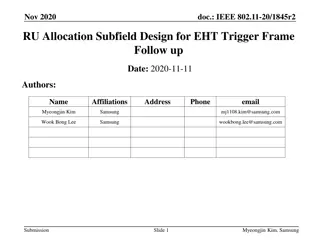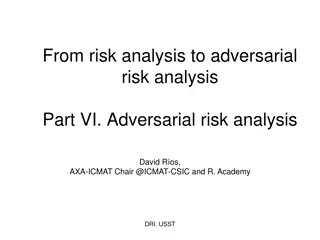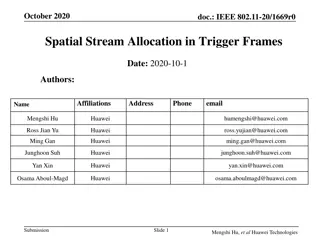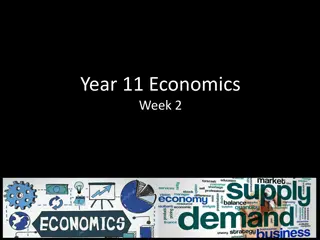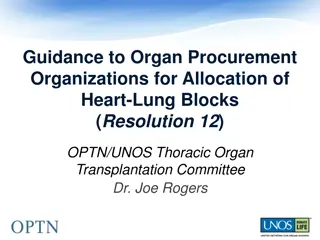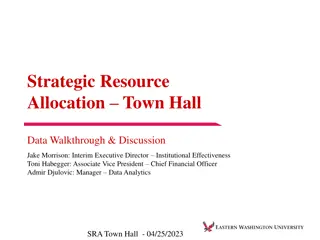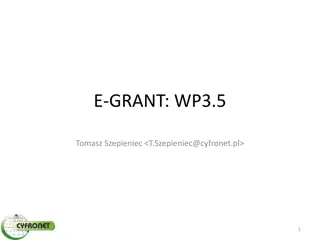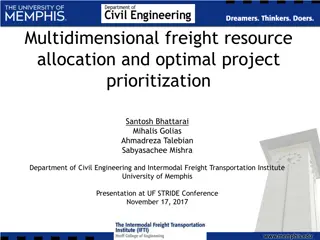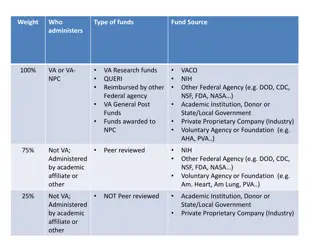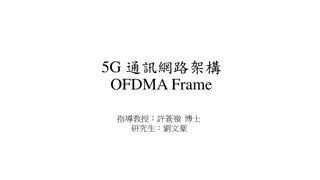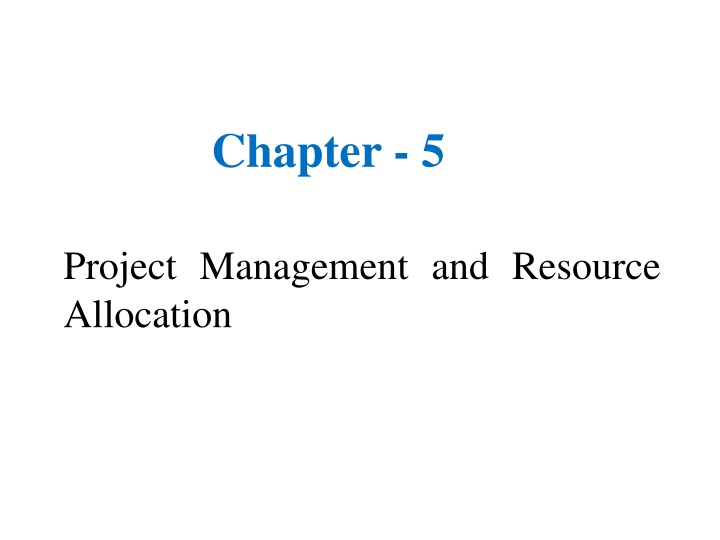
Project Management and Resource Allocation
Project management involves organizing, leading, and completing a project through people. It includes defining objectives, managing resources, and stakeholder engagement. Key points include establishing clear objectives, risks, costs, and resources required for successful project planning.
Uploaded on | 3 Views
Download Presentation

Please find below an Image/Link to download the presentation.
The content on the website is provided AS IS for your information and personal use only. It may not be sold, licensed, or shared on other websites without obtaining consent from the author. If you encounter any issues during the download, it is possible that the publisher has removed the file from their server.
You are allowed to download the files provided on this website for personal or commercial use, subject to the condition that they are used lawfully. All files are the property of their respective owners.
The content on the website is provided AS IS for your information and personal use only. It may not be sold, licensed, or shared on other websites without obtaining consent from the author.
E N D
Presentation Transcript
Chapter - 5 Project Management and Resource Allocation
What is a Project? Unique process consisting of a set of coordinated and controlled activities with start and finish dates, undertaken to achieve an objective conforming to specific requirements, including constraints of time, cost, quality and resources A Project is a planned set of activities A Project has a scope A Project has time, cost, quality and resource constraints
What is Project Management? The art of organising, leading, reporting and completing a project through people
Cont A project is a planned undertaking A project manager is a person who causes things to happen Therefore, project management is causing a planned undertaking to happen.
Project Manager Role A Good Project Manager Takes ownership of the whole project Is proactive not reactive Adequately plans the project Is Authoritative (NOT Authoritarian) Is Decisive Is a Good Communicator Manages by data and facts not uniformed optimism Leads by example Has sound Judgement Is a Motivator Is Diplomatic Can Delegate
Stakeholder A person or group of people who have a vested interest in the success of an organization and the environment in which the organization operates
Key Points in Project Set-up and Definition Create Project Management Plan (PMP) Be clear of scope and objectives Establish clear statement of what is to be done (WBS) Establish Risks to be Managed Establish Costs and Durations Establish Resources Required
Cont Adequate planning leads to the correct completion of work
Cont Inadequate planning leads to frustration towards the end of the project & poor project performance Project Start Project End
Project scheduling Allocation of resources like time , energy, space, equipment, human power
Project Monitoring and Control Typical Monitoring Activities regular reviews of progress against schedule using WBS as basis (Plan against Baseline) regular review of actual costs (O/P from SAP) against budgeted costs and Earned Value at WBS level regular review of resource loading regular progress meetings with project team regular meetings with contractors production of periodic progress reports risk reviews inspections/ audits
Typical Control Activities assign responsibilities at Work Package level staged authorisation of work to be done staged release of budgets (staged release of WBS(e) numbers) ensure PM has a Management Reserve under his control seek corrective action reports when WPs go off track (overrunning or overspending) release Management Reserve carefully
Project Management and Resource Allocation Work Break down Structure (WBS): It is a methodology for converting a large scale project into detailed schedules for its thousands of activities for planning, scheduling and control purpose. By applying the WBS approach, the overall project planning and control can be improved. Individual components in a WBS are referred to as WBS elements, at the lowest level of the WBS the element of work is called a work package.
Contd.. Each WBS component is successively broken down into smaller details at lower levels. This process may continue until specific project activities are reached. Basic approach for preparing a WBS is: 1) Level1: This level contains only the final project purpose. This item should be identifiable directly as an organizational budget item. Level2: This contains the major subcomponents of the project. This subdivision is usually identified by their contiguous location or by their related purposes.
Level3: Level 3 contains definable components of the level 2 subdivisions. Subsequent levels are constructed in more specific detail depending on the level of control desired. If complete WBS becomes too crowded, separate WBSs may be drawn for level 2 components. A summary for the WBS should normally be made to make the structure complete. This should include the objectives of the work, its nature, resource requirements, and tentative schedule. Each WBS element is assigned a code that is used for its identification throughout the project life cycle. Alphanumeric codes may be used to indicate element level as well as component group.
The full scope of the work for the project is placed at the top of the diagram, and then sub-divided uniformly in to smaller elements of work at each lower level of the breakdown. Effective use of the WBS will graphically outline the scope of the project and the responsibility for each work package. Designing the WBS requires a delicate balance to address the different needs of various disciplines and project occasions. Necessarily there is no right or wrong structure because what may be an excellent fit for one discipline may be an awkward burden for another.
Project Breakdown Structure Level 1 Parent Project -- -- -- -- -- -- -- -- -- --- -- --- --- --- --- ---- --- --- ---- ---- --- --- ---- ---- ----- --- --- ---- --- --- --- ---- ----- ----- Level 2 Phase1 Phase2 Phase 3 ---- ------ ------ ------ ----- ------ ------ ----- ---- ------- ------ ------- ----- ------- ----- ----- ------ ------ ------- ------ Level 3 Part 1 Part 2 Part1 Part 2 Part 1 Part 1,2, .n ---- ----- ----- ----- ----- ---- ----- ------ ------ ----- ------ ----- ----- ----- ------ ----- ------ ----- ---- ---- ---- ------ ---- Level 4 Subassembly 1 Subassembly 2 --- ----- ------ ----- ----- ------ ----- ----- ----- ---- ---- --- ---- --- ---- ---- --- ---- --- ---- --- --- --- ----- ---- ---- --- ------ Level 5 Unit 1 Unit 2
b) Project Organization Like any organization, projects can be managed and controlled by using different type of organization structure. The selection of an organizational structure shows the management line and responsibilities of the project personnel. The structure may be defined in terms of functional specializations, departmental proximity, standard management boundaries, operational relationships or product requirements.
Types: 1. Formal and Informal structures: The formal organizational structure represents the officially sanctioned structure of a functional area. The informal organizations, develop when people organize themselves in an unofficial way to accomplish an objective that is in line with the overall project goals. Here not everyone in the organization is aware of its existence. Both these type of organizations are placed in every project environment.
2. Functional Organization: This is the most common type of formal organization, whereby people are organized into groups dedicated to a particular functions. Depending on the size and type of auxiliary activities involved in the project, several minor, but supporting, functional units can be developed for a project. Projects that are organized along functional lines are normally resident in a specific department or area of specialization. The project home office or headquarters is located in the specific functional department.
3. Product Organization: Another approach to organize a project is to use the end product or goal of the project as the determining factor. This is often referred to as the pure project organization or simply project organization. The project is set up as a unique entity within the parent organization. It has its own dedicated technical staff and administration. It is linked to the rest of the system through process reports, organizational procedures and funding. policies,
This type is common in large project- oriented organizations or organizations that have multiple product lines. Unlike the functional structure, this organization decentralizes functions. It creates a unit consisting of specialized skills around a given project or product. Sometimes referred to as team, task force or product group, the product organization is common in public, research and manufacturing organizations where specially organized and designed groups are assigned specific functions.
4. Matrix organization: A matrix organization is a popular choice of management professionals. This organization exists where there is multiple managerial accountability and responsibility for a job function. It has the advantages of both the traditional and the product organization structure. In pure product organization, technology utilization and resource sharing are limited because there is no single group responsible for overall project planning.
In the traditional organization, time and schedule efficiency are sacrificed. There are usually two chains of command: Vertical and Horizontal. The vertical line deals with the project line of responsibility , horizontal line deals with the functional line responsibility. The project manager has total responsibility and accountability for the project success. The functional managers have the responsibility to achieve and maintain high technical performance of a project. Project organized under a matrix structure may relate to specific problems, marketing issues, product quality improvement and so on. Project line in matrix is usually of temporary nature while the functional line is more permanent.
General Manager Director of projects Finance Manufacturing Engineering Project Responsibility Functional Responsibility Project A Project B Project C Project D Matrix Organization Structure
Network Diagram In network modeling of projects, the network diagram is of primary importance. Advantages of network/arrow diagrams: It clearly shows the inter-relationship between events. The project is seen as integrated whole, thus making it easier for control. It can be used even for highly complicated projects consisting of a large number of activities. It directly indicates the time required in between two activities.
1) EVENT: An event is defined to be an instant of time. In a project, an event, may mark the initiation of an activity, the completion of an activity, or the time after which an activity may be initiated. Ex: Design completed, pipe line laid, electricity installed etc. It is represented by a circle O in a network which is also known as a node or connector. a) Merge event: When more than one activity come and join an event, such an event is known as merge event.
b) Burst event: When more than one activity leave an event, such an event is known as a burst event. c) Merge and burst event: An activity may be a merge and burst event at the same time as with respect to some activities it can be a merge event and with respect to some other activities it may be a burst event. C A B
2) ACTIVITY: operation, Any resources and has a beginning and an end, is called an activity. A project may be divided into activities that are time consuming tasks or subprojects like: assembly of parts, mixing of concrete, preparing budget etc. An arrow is commonly used to represent an activity with its head indicating the direction of progress in the project. An arrow represents an activity A whose estimated duration is k unit of time. individual which utilizes A k
Classification of Activity: A) Predecessor activity: Activities that must be completed immediately prior to the start of another activity are called Predecessor activities. B) Successor activity: Activities that cannot be started until one or more of other activities are completed, but immediately succeed them are called successor activities. C) Concurrent activities: Activities that cannot be accomplished concurrently are known as concurrent activities. It may be noted that an activity can be a predecessor or successor to an event or it may be concurrent with one or more of the other activities.
D) Dummy activity: An activity which does not consume any kind of resource but merely depicts the technological dependence is called a dummy activity. It may be noted that the dummy activity is inserted in the network to clarify the activity pattern in the following two ways: 1) To make the activities with common starting and finishing points distinguishable, 2) Identify and maintain the proper precedence relationship between activities that are not connected with arrows. Ex: Consider a situation where A and B are concurrent activities, C is dependent on A, and D is dependent on A and B both.
Such a situation can be handled by using a dummy activity as shown in fig.(a) below. Ex.2 Consider a case where B and C have the same job reference and they can be started independently on completion of A. But, D could be started only after the completion of B and C. This relationship is shown by the dummy line as shown in fig. (b). C A A B D 5 6 1 2 4 5 Dummy activity Dummy activity B C 3 D 7 (a) (b)
Rules for drawing network diagram: 1) Each activity is represented by one and only one arrow in the network: This implies that no single activity can be represented twice in the network. 2) No two activities can be identified by the same events: Ex: Activities a add b in fig. (a) have the same end events. The procedure is to introduce a dummy activity either between a and one of the end events or between b and one of the events.
Modified representations after introducing a dummy activity d is shown in fig. (b). As a result of using the dummy, activities a and b can now be identified by unique end events. It must be noted that a dummy activity does not consume any time or resource. 2 a a a d (Dummy) d b b 1 3 b a a 3 1 1 3 d b d b 2 2
3) Check the precedence relationship: In order to ensure the correct precedence relationship in the arrow diagram, the following questions must be checked whenever any activity is added to the network. a) What activity must be completed immediately before this activity can start? b) What activity must follow this activity? c) What activities must occur simultaneously with this activity?
Important suggestions for drawing good networks: Try to avoid arrows which cross each other. Use straight arrows. Do not attempt to represent duration of activity by arrow length. Use arrows from left to right ( or right to left). Avoid mixing two directions, vertical and standing arrows may be used if necessary. Use dummies freely in rough draft but final network should not have any redundant dummies. The network has only one entry point- called start event and one point of emergence- called the end event.
Common errors in drawing networks: 1) Dangling: To disconnect an activity before the completion of all activities in a network diagram is known as dangling. As shown in fig. below, activities (b-c) and (d-e) are not the last activities in the network. So the diagram is wrong and indicates the error of dangling.
1)Dangling error diagram Fig. e Dangling f a d h b g c
2) Looping or Cycling: Drawing an endless loop in a network is known as an error of looping as shown in the following fig. 14 13 22 15 Looping Looping 20 23 12 21
3) Redundancy: Unnecessarily inserting the dummy activity in a network diagram is known as the error of redundancy as shown in the following fig. 1 1 1 0 12 Redundancy
Scheduling Systems Critical Path Method (CPM) Program Evaluation and Review Technique (PERT) Gantt Chart
CRITICAL PATH METHOD (CPM) Deterministic model Single time estimate for each activity No uncertainty is considered No determination of success/failure probability
CPM is a network diagramming technique used to predict total project duration. A critical path for a project is the series of activities that determines the earliest time by which the project can be completed. The critical path is the longest path through the network diagram and has the least amount ofslack or float. Slack or float isthe amount of time an activity can be delayed without delaying a succeeding activity or the project finish date.
Procedure (procedure) Determine the activities of the project Identify the predecessors and successor activities Allocate resource and time for each activity Draw the network diagram Find the critical path Determine the early start and finish times Determine the latest start and finish times Find the slack time for each non-critical activities
Network Representation Schemes AON Network [Activity-on-Node] AOA Network [ Activity-on- Arrow] AOA Network [ Activity-on- Arrow] Historically most popular Nodes represent start and finish events for each activity Arrows can only come from/go to single node Only one arrow between two given nodes
Example [AOA Network] Activity a b c d e f g h i j Predecessor Duration[days] -- -- a a a b, c d d, e f g, h 5 4 3 4 6 4 5 6 6 4





